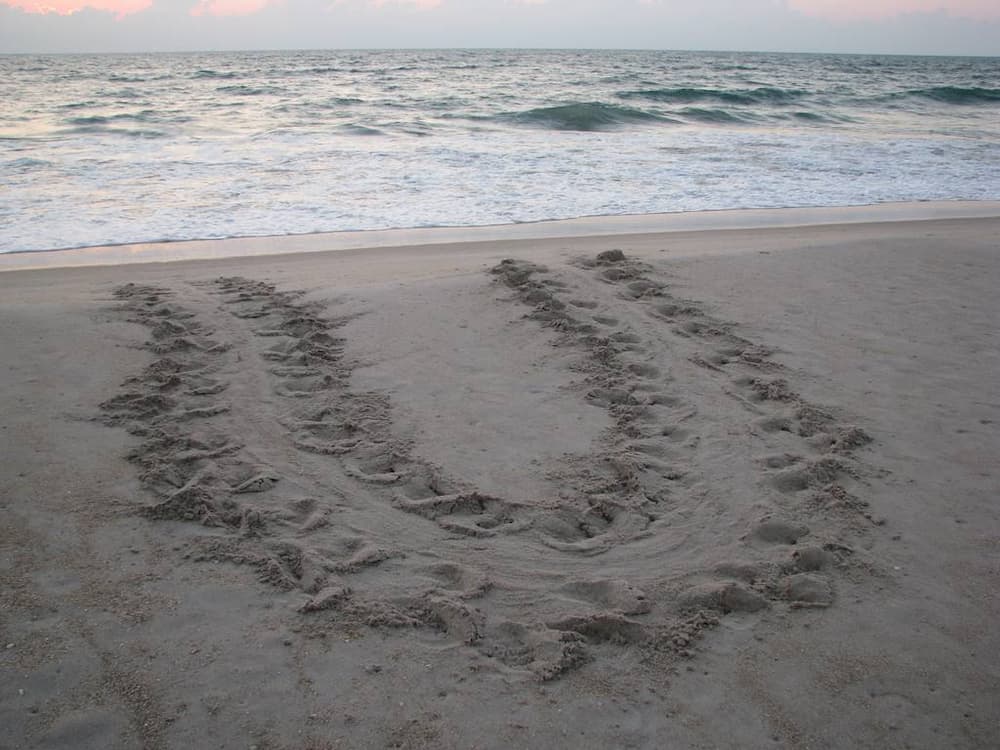Nesting
Sea turtle nesting season in Broward County lasts from March 1 – October 31 each year. The leatherbacks are typically the first nesters to arrive in March, followed by the loggerheads in April, and then the green turtles in June. Sea turtles can be quite unpredictable in their nesting, however, and sometimes our surveyors document nests earlier or later than expected. The peak of nesting season usually falls at the end of June or beginning of July.
If undisturbed, the female turtle will emerge from the ocean, crawl up the beach, and dig an egg chamber in the sand using her rear flippers. She will then deposit the eggs, carefully cover the eggs with sand using her rear flippers, and camouflage the nest using her powerful front flippers before crawling back to the water. The female will never again return to the nest site to assist her hatchlings or care for them. All species of sea turtles follow this same general nesting pattern but differ in some subtle ways including the number of eggs laid. Leatherbacks, being the largest turtles, lay the largest eggs and lay about 80 eggs in a single nest. Their eggs are about the size of small tennis balls. Loggerheads and green turtles lay about 100-120 eggs per nest, and their eggs resemble ping-pong balls in size.
A single female may nest several times during a season and then not again for one or two years. Approximately half of all emergences result in a female crawling on the beach but reentering the water without laying a nest. These are called "false crawls" and usually occur because the turtle was disturbed, or she could not find a suitable nest site. Surveyors use the tracks that are left in the sand by the female to determine if the turtle nested or not, the species, etc. and so it is important for beachgoers to leave these marks and areas undisturbed.

Image: A "false crawl" in which the female sea turtle does not deposit eggs.
Credit: BCSTCP staff taken under Florida Fish and Wildlife Conservation Commission Marine Turtle Permit #214.
Hatching
Sea turtle nests take approximately two months to incubate. After incubation, the hatchlings emerge from the nest and quickly make their way to the ocean. One of the strongest cues upon which hatchlings rely to find the ocean is light and they evolved to crawl toward the brightest light source. Before man-made structural development along our coastline, the brightest light source was the light reflection on the ocean; therefore, if artificial lights are illuminated near the beach hatchlings can crawl away from the water (disorientation), waste energy, and may never make it to the ocean (navigate to the Sea Turtle Lighting section for more information).
Once in the water, loggerhead hatchlings swim a long distance to find Sargassum seaweed patches where they will reside for the first part of their lives. The Sargassum provides shelter and camouflage for the small turtles, and they forage on tiny crabs and shrimp in the seaweed. These patches of seaweed are found floating in the Gulf Stream current off Florida’s east coast. The Gulf Stream joins with the North Atlantic Gyre which flows clockwise up the east coast of the United States and eventually past the Azores in the eastern Atlantic. Scientists once believed that hatchling turtles floated passively in the Gyre, but recent studies suggest otherwise. Using small solar-powered satellite tags, Mansfield et al. 2014 found that young loggerheads (<1 year old) frequently leave the currents of the Gyre and sometimes associate with eddies. This study was one of the first to provide information about the first years of a turtle’s life, what used to be termed “The Lost Years.”
Follow Best Practices When Visiting the Beach
Do not disturb – If you see a nesting female or hatchlings on the beach, observe from a distance and refrain from taking photos. Turn off flashlights and cell phones.
Lights out – Artificial lighting near the beach can confuse adult and hatchling sea turtles. For lights that are needed for safety, use shielded and long-wavelength amber or red LED lights.
Preserve the beach habitat – Sea turtles rely on the sandy beach to complete their life cycle. Keep it pristine by properly disposing of trash, removing obstacles such as beach furniture before sunset each day and filling in holes dug in the sand.
The table below shows the yearly nesting of each sea turtle species nesting on Broward’s beaches (excluding the Dr. Von D. Mizell-Eula Johnson State Park). The alternating patterns of higher and lower nesting observed from year to year are due to the fact that females do not typically nest every single year. This is especially evident in the historical green turtle nesting data. All three species’ nesting has been increasing in Broward County since the start of the Conservation Program in 1981.
2016
| 2400
| 137 | 27
|
2017
| 2898 | 665 | 12 |
2018
| 2733 | 136
| 18
|
2019
| 2813 | 788 | 43 |
2020
| 2835
| 277
| 29
|
2021
| 2330
| 443
| 79
|
2022
| 2903
| 360
| 26
|
2023
| 3480
| 805
| 85
|
